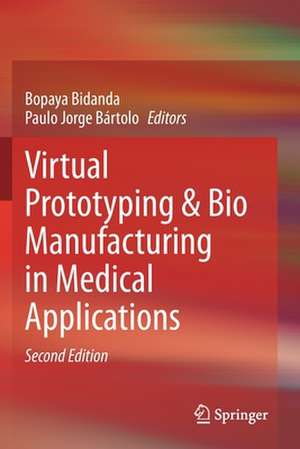Virtual Prototyping & Bio Manufacturing in Medical Applications
Editat de Bopaya Bidanda, Paulo Jorge Bártoloen Limba Engleză Paperback – 23 oct 2021
This new edition focuses on modeling and manufacturing in the field of prototyping and bio manufacturing. The principles utilized draw heavily from more traditional engineering fields including mechanical, industrial, civil (structures), electrical, and bio engineering. Written for engineers and academics seeking a comprehensive overview of virtual prototyping and rapid prototyping, this book discusses in detail applications related to surgery, medical imaging, tissue engineering, bone replacement, and more. Seven new chapters address:
- Two-photon polymerization for tissue engineering
- Molding in medicine
- Organ printing
- Skin printing
- Nerve regeneration and spinal injury repair
- Cartilage regeneration
- And Structural analysis of the human shoulder
| Toate formatele și edițiile | Preț | Express |
|---|---|---|
| Paperback (2) | 842.61 lei 6-8 săpt. | |
| Springer International Publishing – 23 oct 2021 | 842.61 lei 6-8 săpt. | |
| Springer Us – 7 oct 2014 | 1203.52 lei 38-44 zile | |
| Hardback (2) | 1103.75 lei 6-8 săpt. | |
| Springer Us – 17 dec 2007 | 1103.75 lei 6-8 săpt. | |
| Springer International Publishing – 22 oct 2020 | 1165.03 lei 6-8 săpt. |
Preț: 842.61 lei
Preț vechi: 886.97 lei
-5% Nou
Puncte Express: 1264
Preț estimativ în valută:
161.24€ • 169.12$ • 134.22£
161.24€ • 169.12$ • 134.22£
Carte tipărită la comandă
Livrare economică 01-15 aprilie
Preluare comenzi: 021 569.72.76
Specificații
ISBN-13: 9783030358822
ISBN-10: 3030358828
Ilustrații: XII, 293 p. 91 illus., 61 illus. in color.
Dimensiuni: 155 x 235 mm
Greutate: 0.44 kg
Ediția:2nd ed. 2021
Editura: Springer International Publishing
Colecția Springer
Locul publicării:Cham, Switzerland
ISBN-10: 3030358828
Ilustrații: XII, 293 p. 91 illus., 61 illus. in color.
Dimensiuni: 155 x 235 mm
Greutate: 0.44 kg
Ediția:2nd ed. 2021
Editura: Springer International Publishing
Colecția Springer
Locul publicării:Cham, Switzerland
Cuprins
Computer Aided Oral & Maxillofacial Surgery.- Virtual Bone Surgery.- Medical Imaging Challenges Photogrammetry.- Computer Aided Tissue Engineering Scaffold Fabrication.- CAD Assembly Process for Bone Replacement Scaffolds in Computer-Aided Tissue Engineering.- Computational Design and Simulation of Tissue Engineering Scaffolds.- Conventional Manufacturing Process for Three-Dimensional Scaffolds.- Advanced Processes to Fabricate Scaffolds for Tissue Engineering.- Laser Printing Cells.- Two-Photon Polymerization for Tissue Engineering.- Selective Laser Sintering of Polymers and Polymer-Ceramic Composites.- Design, Fabrication and Physical Characterization of Scaffolds Made from Biodegradable Synthetic Polymers in Combination with RP Systems based on Melt Extrusion.- Molding in Medicine.- Organ Printing.- Skin Printing.- Nerve Regeneration & Spinal Injury Repair.- Cartilage Regeneration.- Structural Analysis of the Human Shoulder.
Notă biografică
Bopaya Bidanda is the Ernest E. Roth Professor and Chairman of the Department of Industrial Engineering at the University of Pittsburgh. His research is in the area of manufacturing systems with a special focus on group technology, reverse engineering, cellular manufacturing, lean manufacturing, human issues in manufacturing, product development, and manufacturing modernization.
Paulo Bartolo is Professor of Advanced Manufacturing Processes at the Polytechnic Institute of Leiria (Portugal), Adjunct Professor at Queensland University of Technology (Australia), Visiting Professor at Nanyang University (Singapore), and Professor of Biomaterials (Catedra UNESCO) at the University of Habana (Cuba). He is a CIRP (The International Academy of Production Engineering) member, Vice-Chairman of the CIRP Scientific Technical Committee on Electro-Physical and Chemical Processes, GARPA (Global Alliance of Rapid Prototyping Associations) Portuguese Representative a
nd Member of the Direction Board of the International Society of Biomanufacturing, Scientific advisor of the Research Institute in Biofabrication (BIOFABRIS) funded by the Brazilian Government and regional coordinator of the working group of Rapid Manufacturing Platform. Textul de pe ultima copertă
This new edition focuses on modeling and manufacturing in the field of prototyping and bio manufacturing. The principles utilized draw heavily from more traditional engineering fields including mechanical, industrial, civil (structures), electrical, and bio engineering. Written for engineers and academics seeking a comprehensive overview of virtual prototyping and rapid prototyping, this book discusses in detail applications related to surgery, medical imaging, tissue engineering, bone replacement, and more. Seven new chapters address:
- Two-photon polymerization for tissue engineering
- Molding in medicine
- Organ printing
- Skin printing
- Nerve regeneration and spinal injury repair
- Cartilage regeneration
- And structural analysis of the human shoulder
Caracteristici
Brings together all of the important aspects of virtual and rapid prototyping relative to medical applications in a cohesive manner Provides a comprehensive overview of virtual prototyping and rapid prototyping techniques Covers applications of rapid prototyping in detail including the dental, cardiovascular and biomaterial areas
Descriere
Descriere de la o altă ediție sau format:
We are especially pleased to present our edited book in an area that is quickly emerging as one of the most active research areas that integrate both engineering and medicine. Preliminary research results show signi?cant potential in effecting major breakthroughsranging from a reduction in the number of corrective surgeries needed to the ‘scienti?c miracle’ of generating tissue growth. Over $600 million has been in invested in tissue engineering last year alone—a large and signi?cant component of this is in the area of virtual and physical prototyping. Virtual & Physical prototyping can broadly be divided into three categories: Modeling, Manufacturing& Materials. This book focuses on the ?rst part and some areas of the second.The second bookin this series will focuson the areas in the s- ondandthird categories.As youwill see fromthis book,the principlesutilizeddraw heavily from the more traditional engineering?elds including mechanical engine- ing, industrial engineering, civil engineering (structures), electrical engineering and bio engineering. The ?rst chapter by Winder provides an insight into the practicalities of creating custom made implants for the skull details. The concept of cranioplasty, describing the correction of a bone defect or deformity in the cranium using a bio-compatible material, is described and explored from a computational point of view In Chapter 2, Ming Leu and his group of researchers review the use of virtual reality technology for the development of a virtual bone surgery system, which can be used for training in orthopedic surgery and planning of bone surgery procedures.
We are especially pleased to present our edited book in an area that is quickly emerging as one of the most active research areas that integrate both engineering and medicine. Preliminary research results show signi?cant potential in effecting major breakthroughsranging from a reduction in the number of corrective surgeries needed to the ‘scienti?c miracle’ of generating tissue growth. Over $600 million has been in invested in tissue engineering last year alone—a large and signi?cant component of this is in the area of virtual and physical prototyping. Virtual & Physical prototyping can broadly be divided into three categories: Modeling, Manufacturing& Materials. This book focuses on the ?rst part and some areas of the second.The second bookin this series will focuson the areas in the s- ondandthird categories.As youwill see fromthis book,the principlesutilizeddraw heavily from the more traditional engineering?elds including mechanical engine- ing, industrial engineering, civil engineering (structures), electrical engineering and bio engineering. The ?rst chapter by Winder provides an insight into the practicalities of creating custom made implants for the skull details. The concept of cranioplasty, describing the correction of a bone defect or deformity in the cranium using a bio-compatible material, is described and explored from a computational point of view In Chapter 2, Ming Leu and his group of researchers review the use of virtual reality technology for the development of a virtual bone surgery system, which can be used for training in orthopedic surgery and planning of bone surgery procedures.








